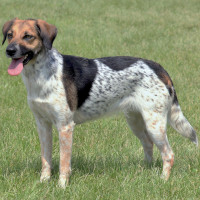 |
Bohemian Spotted Dog |
|
He is not recognized by the F.C.I. |
Origin |
Czechia | |
Translation |
Francis Vandersteen | |
In his country of origin, his name is |
Ceský Strakatý Pes |
| The ancestry of some dogs can be traced as accurately as that of the Czech Spotted Dog. It was created in the 1950s in Frantisek Horak's laboratory. This Czech scientist used the dogs for medical experiments such as kidney transplants, and for research into epilepsy and genetic diseases. The original Horak laboratory dogs were the result of breeding a female Riga with a male Misi in 1954. Their offspring were subjected to further selective breeding, resulting in a new breed with a brown, spotted coat. Horak's laboratory was the only place the dog had been seen, apart from an appearance at a dog show in 1961, until a litter was bred by a private breeder in 1981. Czech Spotted Dogs almost disappeared, with only six remaining in the 1990s, but careful breeding has increased their numbers. Today, it has become a popular dog breed in the Czech Republic, although it is not recognized internationally. Ceský Strakatý Pes are medium-sized dogs of square build and balanced proportions. Their average height is around 46 centimeters. They have a Beagle-shaped head with a flat skull. The muzzle is as long as the skull, the lips close-fitting to the jaw, which has a regular scissor bite. The ears are V-shaped and tilted forward by a curve just above the skullcap, the nose is straight and the eyes almond-shaped and brown. The neck is strong and sloping over a straight back that slopes slightly at the rear. The chest should be spacious but not barrel-shaped, and the belly is taut and tucked up. It has a thick, flat double coat that can be short or long and is tricolored in a combination of brown, beige and white or black, beige and white. There are distinctive black spots on the white patches. The tail is straight and tapered with hair that can be long and lined or short-haired, matching the rest of the coat. The rather tragic beginnings of the Ceský Strakatý Pes had the happy side effect of creating one of the world's easiest, most low-maintenance and sociable dogs. The breed's creators deliberately developed traits that would make them easy to handle in the laboratory, and their offspring were always extremely eager to please and cooperative. They are very good with children and other animals and make excellent pets. They are just as happy in a small apartment as in a house or garden, but they love long walks. Czech Spotted Dogs are very easy to train. They are lively and agile without being boisterous. They form a strong bond with their owners and are very protective, making good watchdogs who bark without becoming aggressive. These dogs are not fussy and have a healthy appetite. Due to the tooth loss and epilepsy research programs for which the dogs were used by Horak, some Czech Spotted Dogs are born with missing molars and premolars and may be prone to epileptic seizures. Breeders are making efforts to eliminate these defects, and dogs with these tendencies should not be used for breeding. |






 English (United Kingdom)
English (United Kingdom)